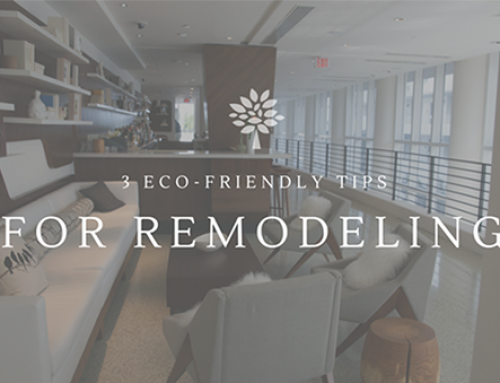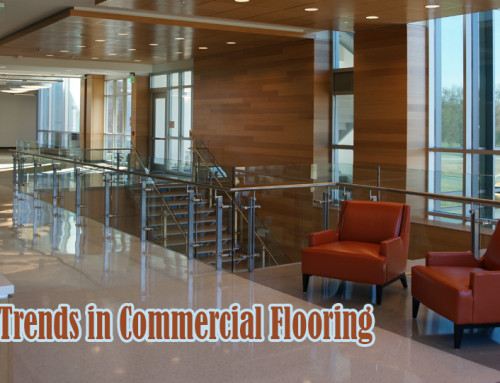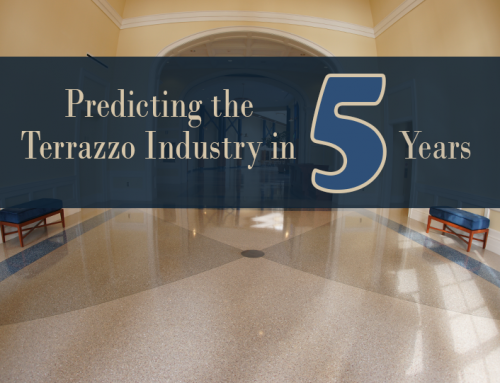A-Z of Terrazzo
Doyle Dickerson Terrazzo will provide a list of terminology from A-Z to help you better understand terrazzo and its features, benefits and impact today.
A
Abrasives: Refers to a material that is capable of polishing a hard surface by grinding
Aggregates: A granule of marble used in the terrazzo topping. Also known as terrazzo chips. Recycled glass, mother of pearl seashells and chips of granite are some common aggregates used in a terrazzo mix.
Aluminum Divider Strips: A common type of divider strip used during the terrazzo installation. Dividers strips can be specified in custom shapes and sizes and help form logos and letter designs.
Amine: Refers to the curing agent for epoxies. This cures at room temperatures.
Antimicrobial: Terrazzo’s surface is non-porous and antimicrobial, preventing the growth of microorganisms. Ideal for healthcare facilities and educational institutions, where the terrazzo floor help eliminate germs.
B
Bonded Terrazzo: a type of terrazzo system. This system is composed of a 1/2″ cement matrix topping. An under bed made of sand and cement bonds with the concrete slab. The terrazzo pours on top. The concrete slab should be depressed 1.75 inches into the group.
Bullnose: Rounded edge, used for horizontal to vertical surfaces to create a smooth transition from various planes and surfaces.
C
Cementitious Terrazzo: A type of terrazzo. Cementitious terrazzo has great durability but precautionary measures are required to prevent cracking. Measures such as ideal weather conditions and low water content should be considered when installing this type of terrazzo.
Chemical Resistance: Most terrazzo coatings are non-reactive and are highly resistant to chemicals.
Cleaner: Reference to a neutral liquid clean used to remove accumulated surface dirt. Terrazzo is easy to clean.
Color Pigments: A powdered substance which, when blended with a liquid vehicle, gives the matrix its coloring.
Compressive Strength: This is a measurement that shows how much force a material can withstand in compression before it breaks.
Concrete Slabs: This is the concrete foundation underneath a building.
Cove Base: Same as bullnose. A rounded edge that creates a smooth transition from various planes and surfaces.
D
Design: Terrazzo remains one of the most versatile in floor design. The floor is a canvas for architects and designers to develop any design possible. With unlimited epoxy colors and patterns, the design is only limited by one’s imagination.
Durability: One of terrazzo’s features. Terrazzo is ideal for high foot traffic areas like schools, hospitals, and airports. It can withstand high levels of pressure, lasting on average up to 75 years.
E
Eco-Friendly: One of terrazzo’s features. Terrazzo benefits the environment because it reduces waste. Terrazzo consists of recycled materials like glass, porcelain or concrete.
Epoxy: To best describe epoxy, think of glue. Like glue, epoxy has a high level of bonding properties that keep materials together providing a protective cover to any surface. The great feature of epoxy is that it can integrate multiple colors for use in the terrazzo design.
F
Floor Grinder: Similar to a floor polisher, this machine grinds the floors after the terrazzo is set. This forms the floor’s smoothness.
G
Galeras: This was one of the earlier tools to grind terrazzo. Terrazzo workers would use this tool by hand.
Grit Level: Grit level refers to the shininess of the terrazzo floor. A lower level indicates a low gloss finish whereas a higher level indicates a high gloss finish.
Grout: Refers to a mixture applied to the floor or grout lines filling the voids.
H
Healthcare: A common location for terrazzo installations. Because terrazzo is antimicrobial, durable and easy to maintain, they make for an ideal flooring option in hospitals. To view Doyle Dickerson Terrazzo healthcare projects, click here.
Hospitality: A common location for terrazzo installations. Terrazzo provides a warm and inviting experience for current and future residents with its sustainability and design features. To view Doyle Dickerson Terrazzo hospitality projects, click here.
I
Installers: These are the people who put epoxy terrazzo or precast terrazzo in place at a job site. Doyle Dickerson Terrazzo is a terrazzo installer company in the United States.
Italy: The birthplace of terrazzo. Venetian construction workers reused marble chips to create what we know as terrazzo today.
J
Joint Control: This refers to control joints placed in a concrete slab to control random cracking.
K
K-12 Schools: A common location for terrazzo installations. Unique design and sustainability help improve the academic performance of young students. To view Doyle Dickerson Terrazzo school projects from the elementary to the high school level, click here.
L
LEED: LEED stands for Energy and Environmental Design. Terrazzo is a perfect building material for sustainable buildings, helping architects achieve LEED points for certification.
Logos: Logos can be a part of the terrazzo design. Many universities and schools incorporate a logo into the floor’s design. Installers will use divider strips to accurately create a precise layout of the design.
M
Marble Chips: The most common aggregates used in a terrazzo design. Venetian workers reused the remnants of marble into creating a new floor, which we now know as terrazzo today. Marble chips come in a variety of different textures and colors and crushed down to different sizes.
Marble Dust: When added with epoxy terrazzo, the marble dust helps increase the thickness of the mix.
Malta: Refers to a sand and cement mix used to form a base for cast in place of terrazzo or precast terrazzo products.
Mix Design: A mix design is a combination of aggregates mixed with an epoxy color choice. Architects receive a terrazzo sample to view how a terrazzo surface will look like.
Monolithic Terrazzo: A type of cementitious terrazzo system where the topping is applied to a concrete slab. The system is composed of a 1/2″ matrix topping.
Mortar Bed: Refers to a thick bed layer of mortar used to set and adhere engineered stone, or precast.
Mother of Pearl: An exotic aggregate that is widely used in terrazzo flooring.
N
NTMA: Acronym for National Terrazzo and Mosaic Association. The NTMA is a great resource for learning about terrazzo. Doyle Dickerson Terrazzo and other terrazzo contractors are members of this association.
O
OSHA: Acronym for Occupational Safety and Health Standards. OSHA is the main federal agency that enforces safety and health regulations. So when an employee is out at the installation site, they must wear safety glasses, hard hats, and other gear for safety reasons.
P
Panels: Refers to the spaces formed by the divider strips.
Portland Cement: A specific kind of cement used for terrazzo.
Polyacyrlate Terrazzo: a terrazzo finish with a minimum thickness of half an inch and a weight of three pounds per square foot. An acrylic additive is used in the mixture, which helps pour the cement either as thinly or thickly as the installer chooses. You can install this system either indoors or outdoors.
Precast Terrazzo: Terrazzo fabricated in molds, finished in a factory and provided to the work site ready for installation. Stair tread and risers, countertops and columns are some of the precast terrazzo items that an installer transports to the job site
PSF: A type of measurement. Pounds per square foot
PSI: A type of measurement. Pounds per square inch
Q
Quartz: Like granite, recycled glass and marble chips, quartz can also be a component of a terrazzo mix. In fact, quartz is one of the most abundant minerals available.
R
Resin: To understand resin, think of as a liquid that when combined with a hardener, it creates a polymerized reaction. The reaction creates a solid form that is truly durable.
Rustic Terrazzo: A terrazzo finish that is textured. Commonly used for outdoor applications.
S
Screed: A technique used to level the top of a mortar bed wit ha wood or metal straight edge.
SDS: Acronym for Safety Data Sheet. Safety Data Sheets must accompany every shipment of a hazardous substance and must be available on the job site.
Sealer: A surface applied product of protective coating which limits foreign liquid or matter from being absorbed, by closing the pores on the surface.
Slurry: A mixture of water and any finely divided insoluble material, such as Portland cement, slag or clay in suspension.
Submittals: Materials such as samples or technical data that are submitted to the architect for approval.
T
Tesserae: Refers to thin slices of marble, colorful stone, or glass cut into squares or other shapes of any size. Commonly used in mosaic work.
Thin Sets: Terrazzo systems which can be applied in a thin cross section (3/8 inch or less) over concrete or other suitable substrates.
Topping: Refers to the wearing surface of a terrazzo floor.
U
Universities: A common location for terrazzo installations. Sustainable materials like terrazzo can improve a student’s academic performance. Classrooms, auditoriums, residence halls, dining halls and sports stadiums have all incorporated terrazzo. Many universities include the school’s logo into the terrazzo design. To view Doyle Dickerson Terrazzo university projects, click here.
V
Volatile Organic Compound: Also known as VOC. These are organic compounds that emit toxic gasses into the air and affect the indoor air quality. Some flooring materials contain VOC content; however, terrazzo contains zero VOC content.
Venetian: Terrazzo originated in Venice, Italy. Venetian construction workers reused marble chips to form a terrazzo floor. The term also refers to chip sizes ranging from a size #3 through #8. They are larger than the standard terrazzo chip sizes.
W
Waterjet: Machine used to cut a variety of materials (aluminum, brass, zinc, etc) under a high-pressure steam of water. These materials aid in the overall terrazzo design.
X
X-Factor: Today terrazzo is trending. Because terrazzo has sustainable features like zero VOC and recycled material, it is a desirable material that can help architects achieve LEED points. One of the first flooring systems is now making its way back into commercial spaces around the world.
Y
Yearly Cost: According to NTMA, the annual cost per square feet for terrazzo is $0.80 over 40 years. That is a cost-effective value when comparing the material to other options like porcelain tile, carpet, and vinyl tile.
Z
Zinc Divider Strips: For thin-set epoxy terrazzo, zinc divider strips are one of the most common dividers strips to use during an installation.
Follow us on Social Media:






